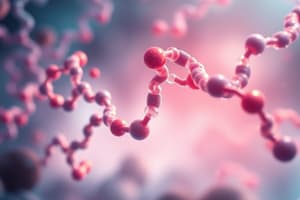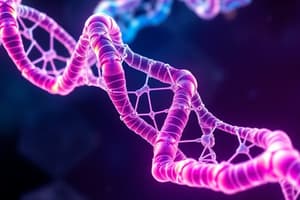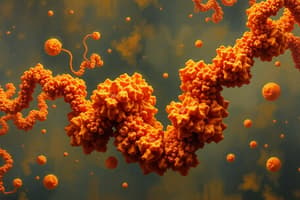Podcast
Questions and Answers
What is the function of bacterial small RNAs?
What is the function of bacterial small RNAs?
- Promote protein synthesis
- Regulate gene expression (correct)
- Facilitate DNA replication
- Inhibit RNA polymerase activity
What is the role of Hfq in bacterial regulatory RNA function?
What is the role of Hfq in bacterial regulatory RNA function?
- Inhibits sRNA-mRNA interaction
- Promotes ribosome binding to mRNA
- Catalyzes mRNA degradation
- Aids binding of short, imperfect matching mRNA-sRNA and stabilizes it (correct)
What is the function of riboswitches in gene transcripts?
What is the function of riboswitches in gene transcripts?
- Control mRNA translation in response to changes in metabolite amount (correct)
- Inhibit mRNA transcription
- Facilitate protein folding
- Promote DNA replication
How do riboswitches respond to changes in metabolite concentration?
How do riboswitches respond to changes in metabolite concentration?
What is the consequence of activated riboswitch structures?
What is the consequence of activated riboswitch structures?
How do regulatory RNAs in bacteria affect mRNA translation?
How do regulatory RNAs in bacteria affect mRNA translation?
What is the role of σS factor in bacterial cells during stationary phase?
What is the role of σS factor in bacterial cells during stationary phase?
What is the function of sRNAs in bacteria?
What is the function of sRNAs in bacteria?
What is the role of 6S RNA in growing E. coli cells during stationary phase?
What is the role of 6S RNA in growing E. coli cells during stationary phase?
What is the function of RNA's single stranded properties in regulatory roles?
What is the function of RNA's single stranded properties in regulatory roles?
What is the role of sRNA binding to key regions in bacterial mRNA translation?
What is the role of sRNA binding to key regions in bacterial mRNA translation?
What is the consequence of riboswitch structures altering ribosome interactions?
What is the consequence of riboswitch structures altering ribosome interactions?
Regulatory RNAs exploit Watson-Crick base-pairing to other RNAs, DNAs to block binding, and alter RNA structure
Regulatory RNAs exploit Watson-Crick base-pairing to other RNAs, DNAs to block binding, and alter RNA structure
Riboswitches are built-in metabolite sensors that use RNA sequences to control mRNA translation in response to changes in metabolite amount.
Riboswitches are built-in metabolite sensors that use RNA sequences to control mRNA translation in response to changes in metabolite amount.
Riboswitches are usually found downstream of genes involved in the synthesis of the metabolite that the riboswitch responds to.
Riboswitches are usually found downstream of genes involved in the synthesis of the metabolite that the riboswitch responds to.
Riboswitches can bind and respond to approximately 19 recognized metabolites, each with unique structures.
Riboswitches can bind and respond to approximately 19 recognized metabolites, each with unique structures.
Activated riboswitch structures only block further transcription, but do not affect any translation.
Activated riboswitch structures only block further transcription, but do not affect any translation.
Riboswitches exhibit protein-like structure diversity.
Riboswitches exhibit protein-like structure diversity.
Small antisense RNAs may be transcribed, bind to, and block target mRNAs in bacterial cells.
Small antisense RNAs may be transcribed, bind to, and block target mRNAs in bacterial cells.
Bacterial small RNAs can regulate gene expression by binding to complementary target mRNAs to form double-stranded RNAs.
Bacterial small RNAs can regulate gene expression by binding to complementary target mRNAs to form double-stranded RNAs.
6S RNA binds RNA Pol and down-regulates transcription in growing E. coli cells during stationary phase.
6S RNA binds RNA Pol and down-regulates transcription in growing E. coli cells during stationary phase.
Bacterial mRNA translation can be regulated by sRNA binding to key regions.
Bacterial mRNA translation can be regulated by sRNA binding to key regions.
Regulatory RNAs in bacteria, such as sRNAs, always serve to repress levels of one protein and promote another.
Regulatory RNAs in bacteria, such as sRNAs, always serve to repress levels of one protein and promote another.
Riboswitches can respond to uncharged tRNAs through the aminoacyl tRNA synthetase gene.
Riboswitches can respond to uncharged tRNAs through the aminoacyl tRNA synthetase gene.
A gene's transcripts in bacteria can directly sense changes in metabolite concentration.
A gene's transcripts in bacteria can directly sense changes in metabolite concentration.
Flashcards are hidden until you start studying




